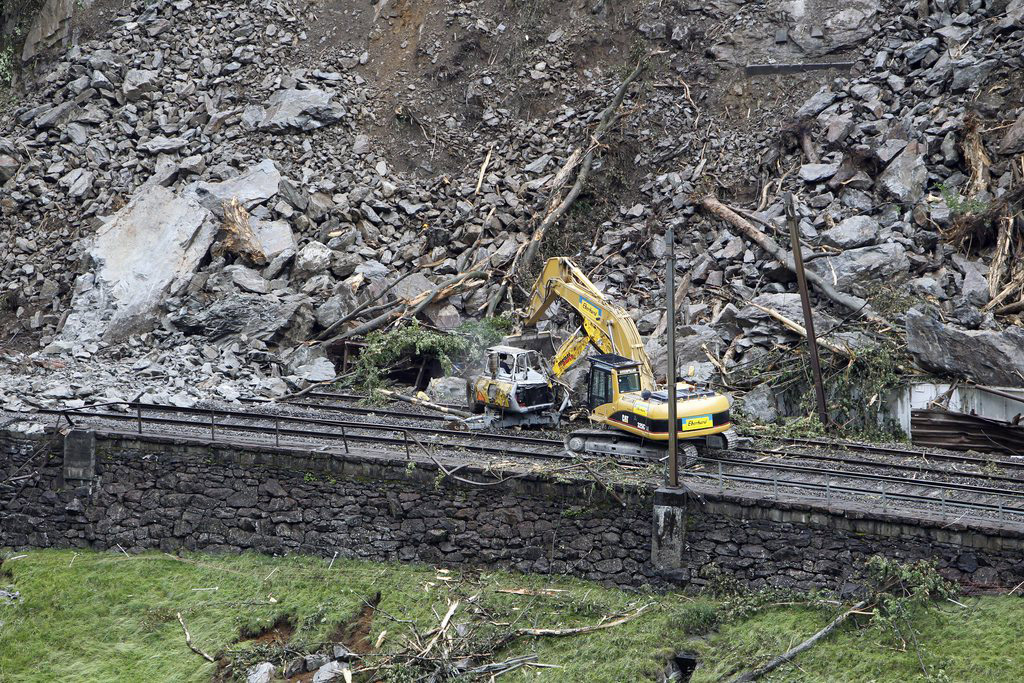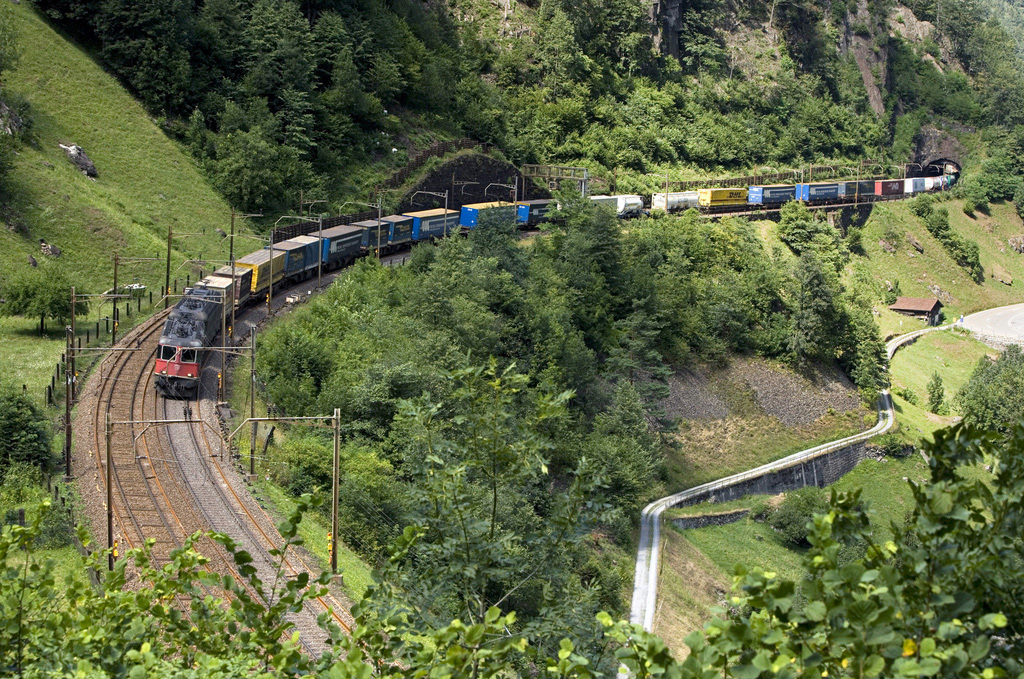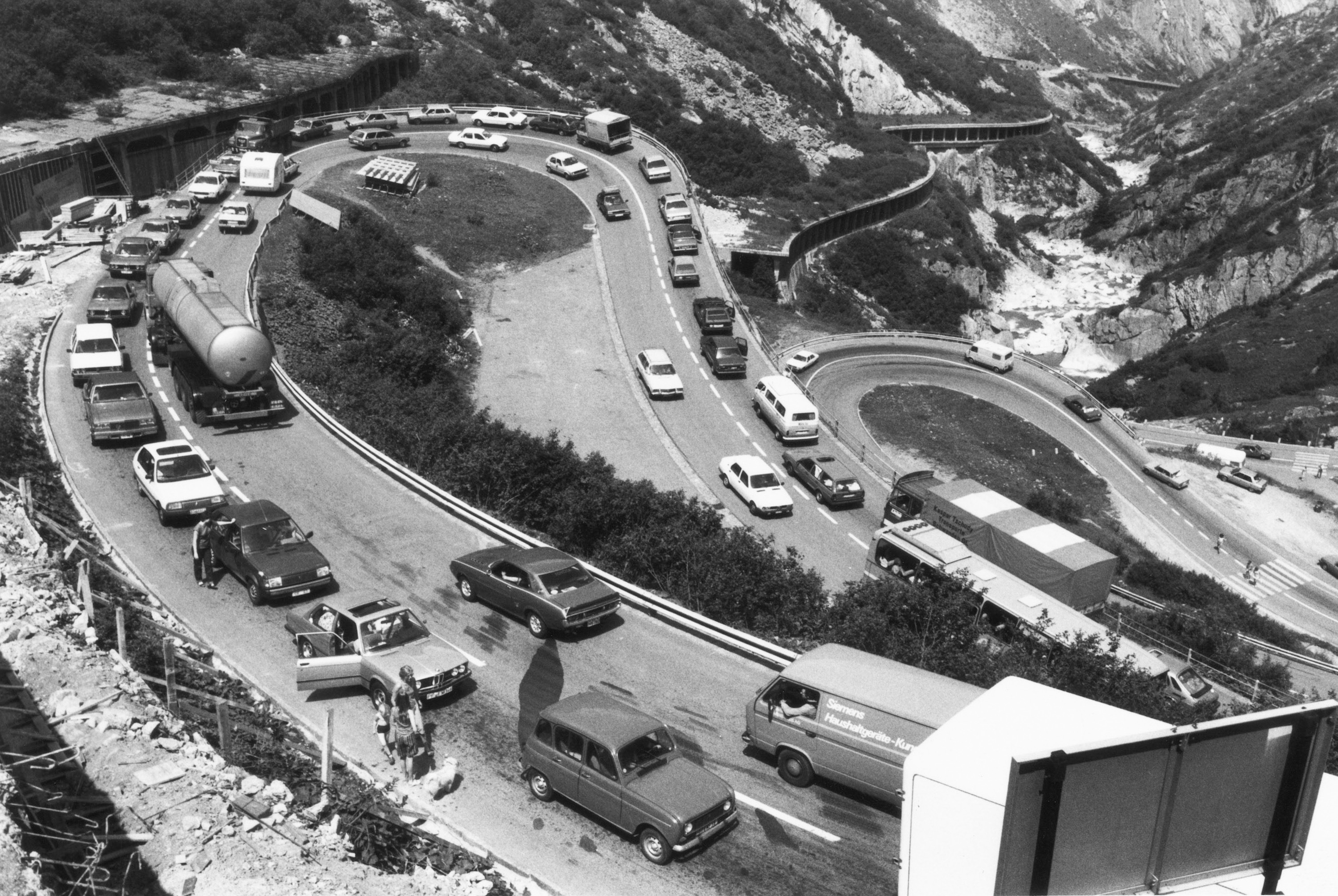Gotthard line changes from asset to weak spot

A major landslide in canton Uri that cut off the central railway line between the north and south of the country has highlighted the economic importance of Switzerland’s alpine crossings.
Whoever wants to cross the Swiss Alps by train or road has two alternatives: the Gotthard (rail or road tunnel) in central Switzerland or the Lötschberg-Simplon axis (rail or Simplon pass) in cantons Bern and Valais. The Gotthard is the faster and more direct connection.
However, it’s been closed since June 5 due to the landslide and is not expected to be reopened until the beginning of July.
“What differentiates Switzerland from other alpine countries is the fact that a relatively large proportion of commercial goods is transported by train through the Alps,” Kilian Elsasser, historian and Gotthard expert, told swissinfo.ch.
The Austrians, thanks to a liberal transport policy, have eclipsed the Gotthard as the most important transit axis through the Alps with the Brenner Pass. However the Gotthard is still the most important alpine transit route for rail traffic.
No way out
According to Swiss Federal Railways some 120 freight trains travel the Gotthard route daily. In 2010 they transported 14.4 million tons of goods.
Due to the Gotthard closure, some of the freight trains have been transferred to the Simplon route. But maintenance and restoration work being carried out on the Lötschberg-Simplon axis in Valais and on the Brenner, has limited their potential to relieve the pressure.
Another possible route – via France – is not an alternative according to experts. “Technically the Mont Cenis tunnel uses a different railway system from the Swiss railways,” Ulrich Weidmann, of the Institute for Transport Planning and Systems at ETH Zurich, told swissinfo.ch.
Limited damage
“The Gotthard is the shortest route between Rotterdam, Germany’s Rhine-Ruhr area on one side and Italy’s Lombardy region on the other. That makes it a very important axis for goods transport, and crucial for industry in northern Italy,” transport economist Rico Maggi of the University of Lugano said.
The volume of transalpine goods transported between northern Switzerland and northern Italy in particular – more than a quarter of the total – has great importance for the Swiss economy. Goods which just pass through Switzerland have no direct influence on it.
Maggi worked out during an earlier closure of the Gotthard the time and detour costs for goods traffic to and from the Italian-speaking Swiss canton of Ticino.
“The shorter the interruption, the sooner the companies can adapt their logistics by postponing shipments,” he said. In this way costs are only incurred by the hauliers. He estimates the current closure will cost upwards of SFr10 million ($10.45 million).
“It is not the case however that a one-month closure would have such a large economic impact that companies would question where to locate,” Maggi added.
Controversy
He says the unreliability of the line is the bigger issue economically, therefore the goal should be to improve the alternative routes.
“The joke with the Gotthard is not that we are concentrating on one axis but that there is a lack of willingness to provide two alternatives, namely a four-lane Gotthard car tunnel and a Gotthard base [rail] tunnel plus the mountain pass road.”
Maggi is referring to the construction of a road link via two tunnels – a hotly-contested project whose future the government has promised to address soon. The road hauliers association and canton Ticino authorities are also pushing for two tunnels.
But the lobby group, Alpine Initiative, is continuing to fight against the plans. They say the will of the Swiss electorate – which voted against a second tunnel in 1994 and 2004 – must be respected.
After the closure of the rail line earlier this month, the company Hupac, which operates trains designed to carry containers or whole trucks (intermodal transport) through the Alps, expressed fears the hauliers could turn their backs on the system due to the Gotthard’s unreliability.
But Maggi refutes that. “They were not using the line before to save the world but because it made sense. They will also return to the rail as soon as it’s possible because the short-term adjustments will become more expensive than transport by rail.”
Bottleneck
The Gotthard is an Achilles heel for Switzerland and will remain so, according to Weidmann. “It’s a transport route across a difficult landscape and there are hardly any viable alternatives.”
The significance of the Gotthard axis should be seen in the context of Switzerland’s overall transport policy, according to Weidmann.
He thinks the Gotthard base tunnel (New Rail Link through the Alps – NRLA), currently under construction and due to be finished in 2016, should ease the dependency.
Rail historian Elsasser sees NRLA as “a new axis diminishing the risk that a temporary closure of one route could shut down an entire economy”.
On June 5 up to 3,000 cubic metres of rock came tumbling down near Gurtnellen in canton Uri injuring two workers and killing a third.
The men were securing the site of a smaller landslide in March, closing the line for five days while other rocks were dynamited and the site cleaned up.
On June 18 some 2,500 cubic metres of rock were dynamited in a controlled explosion to remove the risk of further landslides.
The line is due to open again on July 2.
The Gotthard Base Tunnel (ready 2016) and Ceneri Base Tunnel (ready 2019) will create an ultramodern flat rail link whose highest point is at 550 metres above sea level. This is much lower than the highest point of the existing route through the mountains at 1,150 metres.
The route through Switzerland becomes flatter and 40km shorter, so faster for passengers. Freight trains travelling on the flat route can be longer and pull up to twice today‘s weight – 4,000 tonnes instead of 2,000 tonnes. They will be up to twice as fast.
These two tunnels, plus the Lötschberg base tunnel (opened 2007), are the key elements of the NRLA (New Rail Link through the Alps).
(Translated from German by Clare O’Dea)

In compliance with the JTI standards
More: SWI swissinfo.ch certified by the Journalism Trust Initiative



You can find an overview of ongoing debates with our journalists here. Please join us!
If you want to start a conversation about a topic raised in this article or want to report factual errors, email us at english@swissinfo.ch.